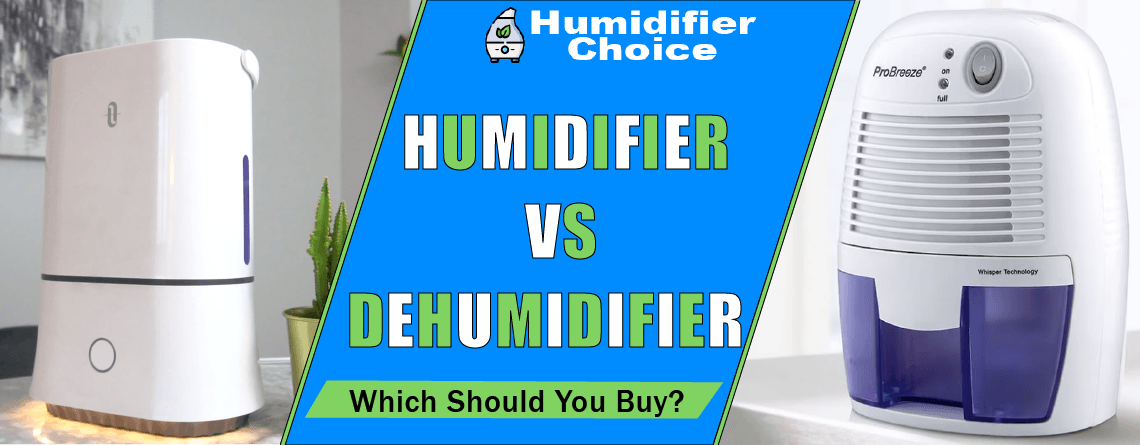Experts recommend that the ideal level of humidity that has a good impact on your and your family’s health is between 30% to 50%. But this level is not always maintained when there is excessive humidity or due dry heat. Although, if the moisture level is above or below the ideal moisture level, you will either need a humidifier or a dehumidifier. Here we discuss a Humidifier VS Dehumidifier with all their types, which helps you choose the right device that fulfills your needs.
However, by using a hygrometer, you will know about the moisture level and then easily decide to use which device is between a humidifier and a dehumidifier. If the moisture is too much, you need to use a dehumidifier that reduces the air’s moisture by drawing excess water vapors. But if the air is very dry, you need to use a humidifier that adds moisture to the air with the help of water vapors and reduces dryness. So, by reading this article, you will be guided to know the difference between Humidifier vs Dehumidifier.
Both devices help maintain an ideal humidity level by increasing or decreasing the moisture level of the environment. The ideal moisture level is essential for humans and houseplants. Adequate humidity level helps give you relief from many problems and is also good for people with asthma. It also helps in the essential growth of your houseplants and prevents them from looking dull because some plants need lots of moisture to grow properly. So, use any device, a humidifier or dehumidifier, according to your atmospheric conditions.
What is a Humidifier?
A humidifier is an instrument used to increase the humidity level and decreases the dryness of the air to give you a comfortable humid atmosphere. It converts water into vapors as a form of mist to enhance the moisture, keeping you moisturized and preventing many allergies like chapped lips, itchy eyes, sneezing, coughing, nosebleeds, etc.
However, if the air around you is very dry, you must use a humidifier because low humidity causes many problems. Humidifiers are also the best option to use in babies’ rooms as it helps in reducing their respiratory issues and provides a soothing atmosphere to breathe. Humidifiers come in a variety of sizes that can be used for small, medium, and large-sized rooms.
Types of a Humidifier:
There are different types of humidifiers that work differently from one another, but they all provide you with sufficient moisture to keep you hydrated. Here we look at different types of humidifiers and their working. There are generally two types of humidifiers: Cool Mist and Warm Mist Humidifiers which are further divided into other types.
1. Warm mist humidifiers:
The warm mist humidifier uses a heating element to boil water to convert it into vapors and gives you a soothing warm effect. It gives you temporary relief from cough, cold, flu, and congestion sinusitis, especially in winter. The warm mist humidifiers further have steam humidifiers.
Steam Humidifiers:
Steam humidifiers are warm mist humidifiers that use heating material to give steam in your room by boiling the water. Because of this steam, the moisture level of your room increases to a sufficient level. You can also add essential oils or inhalants to fill your room with a fresh aromatic fragrance in this humidifier.
These humidifiers are also called vaporizers. They give you the benefit of a humidistat that automatically adjusts the moisture according to the ideal humidity level. But it would be best to be careful while using these models in your kid’s rooms because they use heating material that increases the risk of burns which is dangerous for your children.
2. Cool mist humidifiers:
Cool mist humidifiers usually use a fan and a filter through which it converts water into vapors to give you a soothing chilling effect. These humidifiers are the best option for people with asthma as they provide a fresh mist for breathing comfortably. The cool mist humidifier is further divided into four types given below.
Impeller Humidifiers:
The impeller humidifiers use a rotating disc with comb-shaped wings, which converts the water into small droplets and gives you a fine mist. These droplets enhance the moisture to a sufficient level and reduce dryness in the air. But these humidifiers are not very famous because they are noisy in their work and are less efficient than other models.
Evaporative Humidifiers:
The evaporative humidifiers are cool mist humidifiers that use a wick filter-like cloth to absorb water, and then with the help of a fan, water evaporates. After evaporating, it spreads throughout your room and gives you moisture. They are cheaper and budget-friendly than other models.
Ultrasonic Humidifiers:
Ultrasonic humidifiers are the advanced form of humidifiers that uses a diaphragm that vibrates at a very high frequency to convert water into droplets and then release the water droplets into your room to give you moisture. These humidifiers are very quiet in their operation due to their ultrasonic technology, so there is no disturbance while you are sleeping.
Central Humidifiers:
Central humidifiers are also called whole-house humidifiers. These humidifiers can be connected to your home’s HVAC and plumbing systems. Although these humidifiers are very expensive than other types, they give humidity throughout your house, not just in a specific room. So, you don’t need to buy multiple humidifiers to get moisture for your whole home.
Maintenance of a humidifier:
For the good performance of your humidifier, you have to pay proper attention to its maintenance. To maintain it appropriately, you have to do the following things.
Firstly, always use demineralized, purified, or distilled water to fill the tank of humidifiers because it contains almost no minerals, which prevents mold growth in the tank and increases the lifespan of our humidifier.
Secondly, when you clean the humidifier, wash and dry it properly to prevent the spread of hazardous chemicals. Thirdly, you need to clean and dry the humidifier regularly, as prolonged exposure to water in the tank enhances the risk of bacterial overgrowth.
Lastly, always try to dry the place around the humidifier. This helps identify the leaks and reduces the chances of mold growing around the model.
What is a Dehumidifier?
When you live in a place with too much moisture, you have to add a dehumidifier to your home. Because too much moisture is not good for you, it enhances the bacteria growth in the tank. A dehumidifier is an instrument used to reduce the humidity of the air by extracting excess moisture in the form of water vapors.
It usually works on the principle of a refrigerator-based system through which it eliminates excess moisture to maintain an ideal humid atmosphere. This extra moisture is then pulled into the device with the help of a fan and pass it through a heat-based area which takes it to normal room temperature. Using a dehumidifier is also essential for asthma patients as they are easily triggered when there is excess moisture in the air which enhances mold growth.
Types of a Dehumidifier:
Like humidifiers, there are several different dehumidifiers with distinct working methods. The different types of dehumidifiers are given below.
1. Thermoelectric Dehumidifiers:
Thermoelectric dehumidifiers are usually best for small areas or rooms of up to 300 cubic feet. They use a fan to draw the moisture from the atmosphere and move it through a cool surface. On this cool surface, due to the condensation process, moisture comes out from the air, and then the dry air returns to your room to reduce excess humidity. This type of dehumidifier is very silent in its operation so you can place it in your bedroom without any interruption at night.
2. Refrigerated Coil Dehumidifiers:
Refrigerated coil dehumidifiers are a very common type that works on a refrigerated coil with the help of a fan to draw in humid air to run the process of condensation. Moisture accumulates on the coil for dripping into a certain water space as it works on the same principle as a refrigerator. Then the dry air heats up again and returns to your room.
These dehumidifiers are also called compressor dehumidifiers. They have built-in compressors, which are opposite to thermoelectric dehumidifiers. Refrigerated dehumidifiers perform perfectly when the air temperature is more than 19 degrees Celsius. The dehumidifier reduces moisture from the atmosphere, so the humidity level should be above 45% to use this device.
3. Desiccant Dehumidifiers:
These dehumidifiers use desiccant materials or a chemical material used to soak humidity from the environment. The desiccant material is a wheel in the dehumidifier that is rotated on the belt in a certain area by heating the end of the mechanism to bring out moisture. This wheel use silica gel that helps in keeping the air dry. This dehumidifier runs perfectly if the outside moisture level is high and the temperature is low.
Using this dehumidifier, the moisture level will be sufficient, under 35% to 40%, which is best for industrial operations. However, these dehumidifiers do not store water because it does not reduce humidity using the condensation procedure. Moreover, large-sized desiccant dehumidifiers must possess a generator. So there is no need to worry if you have a problem with power variation.
4. Ionic Dehumidifiers:
Ionic dehumidifiers are usually used in chemical engineering or water filtering. When the environment is at a molecular level, the particles of water present in the atmosphere are removed in the form of liquid or gas. The ionic membranes use the method of electrolysis to draw water particles from the atmosphere, even though water apparently cannot be produced. These types of dehumidifiers need very less maintenance than other models.
Maintenance of a Dehumidifier:
Maintenance is essential if you want the best performance from your dehumidifier and plays an important role. To maintain it, you have to pay proper attention to its cleaning. For this purpose, do the following.
Firstly, you have to wipe out the water tank regularly and clean the coil properly. Because if the water remains in the water tank for a long time, there is a risk of mold and bacteria growing inside the tank. Which is not good for your and your family’s health.
Secondly, you need to regularly check the coil when the weather is cold to avoid frost build-up. Because frost build-up is not good for your dehumidifier and affects its performance.
Comparison Between Humidifier VS Dehumidifier:
Here we give you a comparison chart to clearly understand the difference between Humidifier vs Dehumidifier with all their benefits. With the help of this chart, you know which device is perfect for meeting your needs properly. The comparison chart is given below.
| Features | Dehumidifier | Humidifier |
|---|---|---|
| Purpose | It reduces moisture levels in the atmosphere. | It increases the humidity level of the outside environment. |
| Types | There are four types of a dehumidifier. | There are two types of a humidifier. |
| Benefits | It gives you relief from allergies by reducing dust particles from the air. | It keeps your skin hydrated and moisturized the nasal passages to give you relief from many problems caused due to dry air. |
| Moisture Level | Use when the humidity level is more than 50%. | Use when the humidity level is more than 30%. |
| When To Use | Use in warm seasons when there is too much moisture. | Especially use in winter when the air is dry because of cool air. |
| Energy Consumption | They consume more energy compared to humidifiers. | They consume less energy than dehumidifiers. |
FAQs About The Humidifier VS Dehumidifier:
Final Verdict About Humidifier VS Dehumidifier:
The choice depends entirely on your needs and the area where you live where you choose which device is best for you a humidifier vs a dehumidifier. If you want to get rid of excess moisture, you have to go for a dehumidifier. However, if you want relief from dryness, you need to choose a humidifier that increases the humidity significantly. Although, both devices are best for maintaining an ideal humid environment. Reading this article will clearly understand the difference between a dehumidifier and a humidifier. Therefore, you can use any of both devices that meet your requirements.
If you want more information about humidifiers, diffusers, and air purifiers, you can check out our website.

Christine Jones has worked on a wide range of projects, but her main focus is writing about the products that play an essential role in our daily lives. She did researches and investigates interesting topics and shares her experiences with others by providing more information. She firmly believed that you could virtually do anything yourself with the proper knowledge and product. Christine Jones is also an award-winning scenic designer. Moreover, She teaches in the Arts School “At NYU’s Tisch” and is addressed at Princeton. Her future projects include Starring Peter Dinklage, Cyrano, NY, etc.







